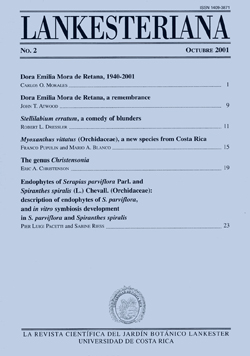Endophytes of Serapias parviflora Parl. and Spiranthes spiralis (L.) Chevall. (Orchidaceae): description of endophytes of S. parviflora, and in vitro symbiosis development in S. parviflora and Spiranthes spiralis
DOI:
https://doi.org/10.15517/lank.v1i2.23147Keywords:
O r c h i d a c e a e, S e r a p i a s p a r v i f l o r a, S p i r a n t h e s s p i r a l i s, s y m b i o t i c f u n g i, e n d o p h y t e s, Italy.Abstract
E n d o p h y t e s w e r e i s o l a t e d f r o m S e r a p i a s p a r v i f l o r a ( O r c h i d a c e a e ) r o o t s . T h e y a r e described and partially classified under microscope, after growth on PDA. Two fungi had symbiotic characters: A-Sepa-1, an ascomycete, and B-Sepa-1, a basidiomycete. At the same time, many plants of S. parviflora and Spiranthes spiralis were asymbiotically obtained by sterilisation of seeds and sowing on modified Frosch medium. After transplantation to symbiotic medium (modified Basic Oats), they were inoculated with isolated fungi. Serapias parviflora was used as control and S. spi ralis was used to establish specificity between hosts and endophytes. The two fungi were able to induce symbiosis in S. parviflora roots in vitro, while only B-Sepa-1 induced symbiosis in S. spiralis roots in vitro. We conclude that specificity between these fungi and the two orchid species studied in vitro is different, possibly substantiating the hypothesis of a potential and ecological specificity.
Downloads
Downloads
Published
How to Cite
Issue
Section
License
According to the Open Access policy promoted by the University of Costa Rica, all the papers published by Lankesteriana are licensed under the Creative Commons copyright and can be downloaded free of charge. The journal holds copyright and publishing rights under the CC BY-NC-ND 3.0 CR license.
Before the publication of the materials submitted by the author(s) in LANKESTERIANA, the author(s) hereby assign all rights in the article to the Lankester Botanical Garden.





